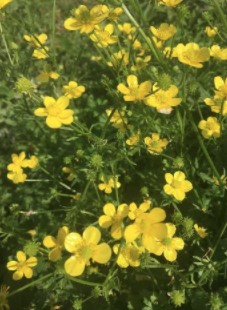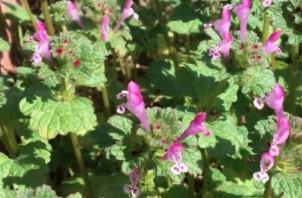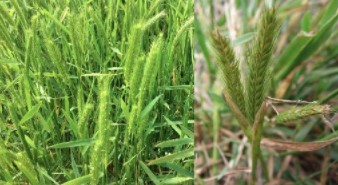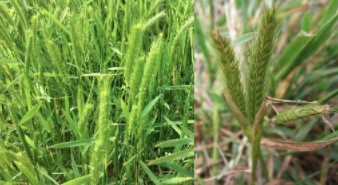By Rocky Lemus
Winter annual weed competition can be damaging to early spring forage field. Most winter annual weeds will germinate in late fall, grow during the winter months, and reach a reproductive stage in the early spring when they become more problematic and then senescence (die) when temperatures increase in late spring. Those plants that reach the seed production stage will leave seed behind that will germinate the following fall.
Weed control decisions in pastures are usually based on visual thresholds and making sure that you can target as many weeds species as possible with a broad spectrum herbicide application. Fields should be scouted to determine if a treat- ment is warranted. The herbicide selection, application rate, and application time will depend on the growth stage of the target weed species. These milder temperatures that we are experiencing can provide ideal conditions to control some of those troublesome weeds.
What are the some of the common troublesome winter weeds in pastures? – Some of the most common trouble- some winter weeds include buttercup, henbit, musk thistle, and wild barley.

Buttercup (Ranaculus sardous) is an annual broadleaf weed with deeply lobed leaves and also known as crow- foot. It has a fibrous root system or thickened rootstock or bulbs. The green stem can be a single stalk or can branch from the base with hairs. The leaves form a rosette at the base of the plant. The leaves in the stem are usually alter- nated, lobed or divided. Buttercup producers shiny, gold- en-yellow flowers with five petals and five green sepals. Buttercup can be toxic to all species of livestock due to an irritant oil called protoanemonin. This toxin is released by the plant when it is chewed or wounded. This toxin is pre- sent in both the stems and leaves and mature flowering plants higher toxin concentrations than younger plants. Although buttercup toxicity is uncommon in cattle, it can occur when there is short supply of forage for the animal to consume, but buttercup is usually unpalatable. Some signs of toxicity include blistering of the mouth and internal parts of the ruminal tract, abdominal pain, severe diarrhea, colic, convulsions, and in severe cases, death. In lactating cows, the milk will be bitter and may be reddish in color. Buttercup toxicity in hay should not be a concern since the toxin becomes inactivated when it is dried. For chemical control, 2,4-D will effectively control buttercup, but depend- ing on what other target weeds might be present, other herbicides such as paraquat, triclopyr plus fluroxypyr, aminopyralid plus metsulfuron, diflufenzopyr plus dicamba, nicosulfuron plus metsulfuron, triclopyr plus clopyralid, picloram plus fluroxypyr, chlorosulfuron, and herbicide mixtures containing 2,4-D with dicamba or picloram are highly recommended. Although weather conditions can be different each year, late February to early march might be the best time for late winter herbicide application. During this time, buttercups are actively growing and that not started to bloom.

Henbit (Lamium amplexicaule) is an annual winter broadleaf weed that sometimes gets confused with purple nettle. It is probably one of the most common winter annual weeds in annual ryegrass pastures along with buttercup. Henbit has a fibrous root system. The plant has rounded or triangular leaves and hairy green or purplish square stems with ascending branches. The leaf margins have rounded teeth with very distinctive veins. Leaves tend to be dark green above and light green below. It has bright pink/purple flowers with long necks. The plant can reach growth heights of 12 to 16 inches. Henbit is a shade-resistant weed that can survive well under small grain or annual ryegrass pastures. The herbi- cide 2,4-D alone is usually not very ef- fective against controlling henbit. On the other hand herbicides such as para- quat, triclopyr plus clopyralid, mixtures of 2,4-D with glyphosate, dicamba, pi-cloram, aminopyralid, metsulfuron, or metsulfuron plus dicamba could be more effective in controlling henbit. The best time for control is usually late November or mid-February to mid-March.

Musk Thistle (Carduus nutans) is a biennial winter weed also known as nod- ding thistle and nodding plumeless this- tle. It has a fleshy tap root. Basal ro- settes are usually well developed and leaves are dark waxy green, alternate, deeply lobed and spiny white margins. The leaves also have a very distinctive light green midrib. This weed can devel- op a single or several stems from the base of the rosette and highly branched at the top. Most of the flowers appear in late May to early June. Flowers form at the top of the stem and they can be deep rose, violet or purple, and occa- sionally white with lance-shaped spine bracts at the base of the flower. The seeds are long, shiny, and yellowish- brown with a plume of white-like bristles. Seed can mature and are dispersed by wind 1 to 3 weeks after flowering. It prefers moist, bottom land soil, but can also be found on drier uplands. Musk thistle is a prolific seed producer with approximately 10,000 seeds per plant and a single plant can produce up to 100,000 seeds in one season. Those seeds could be viable in the soil for up to 10 years. There are different type of thistles (bull, tall, Canada, sow thistle, etc.) that can be very invasive and they should be con- trolled during the winter or very early spring for better control. Glyphosate and paraquat can be used effective treat- ments to control thistles if they are in the rosette stage (laying close to the ground). If the thistle has bolted (began to raise from the ground and put a stalk) or are producing seed heads, they can be more difficult to control. Herbicide treat- ments that can be effective against mature thistles include 2,4-D, metsulfuron methyl, and mixtures of 2,4-D with piclo- ram, aminopyralid, or dicamba. The best time for control in mid-February to April.

Wild Barley (Hordeum pussil- lum) is a short winter annual grass also known as foxtail bar- ley or little barley and it resem- bles wheat or barley with it reaches maturity. It is a shallow -rooted bunchgrass weed that can producer in most soil types. Seeds germinate at the soil sur- face in cooler temperatures in the fall, but are common in the spring. This bunchgrass is very distinguishable by its long awns of bristles. Mature leaves have flat blades that are evenly spaced with fine hairs along the edges and a membranous ligule. The leaf sheath has split, over- lapping, and translucent mar-
gins. The stems are slender and erect. The seed heads form spikes the most upper part of the stems and they have long, fine needle like awns or bristles that can poke the mouth of livestock. Seed heads turn brown when mature. Seed are dispersed by wind and seed viability declines rapidly after three years. In dormant pastures, little barley can be con- trolled with a diuron (pre-emerge), glyphosate, sethoxydim, nicosulfuron plus metsulfuron methyl (dormant bermu- dagrass), imazethapyr, or glyphosate in combination with nicosulfuron plus metsulfuron. Little barley can be controlled with nicosulfuron plus metsulfuron if applied before the mid-boot stage. The best time for control in early-March to early April.
Due to the chemical composition of herbicides, it is always important to read the label before handing, mixing, or apply- ing herbicides and to practice good stewardship. Legumes such clovers interseeded with cool-season grasses can be severely injured or killed by herbicides products used to control some these troublesome winter weeds.
Glyphosate and paraquat should not be applied except during extended periods of mild temps (3 days at 60 °F or more). For best herbicide activity, wait until daytime air temperatures are greater than 50 °F for two to three consecutive days. Several of the herbicides used in forage production usually have grazing and haying restrictions associated with the ap- plication. For more information on haying and grazing restriction associated with herbicides and application rates, please consult the forage section in the Weed Control Guidelines for Mississippi (Publication 1532) at http:// extension.msstate.edu/sites/default/files/publications/publications/p1532.pdf